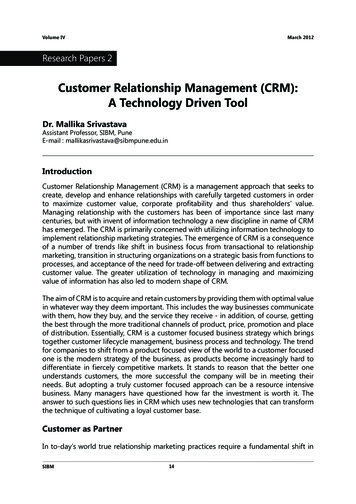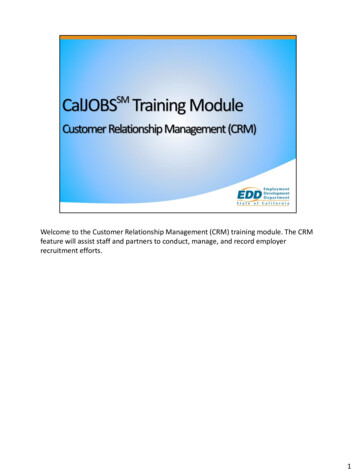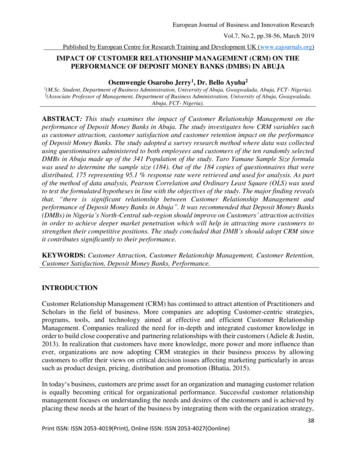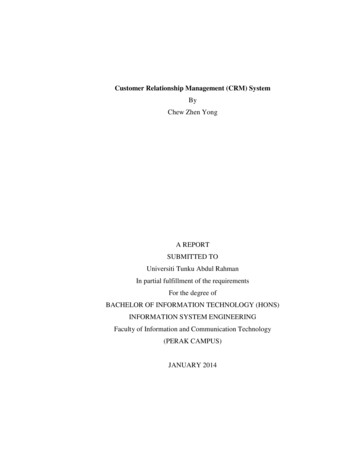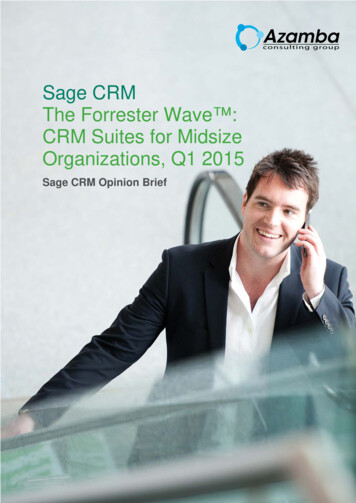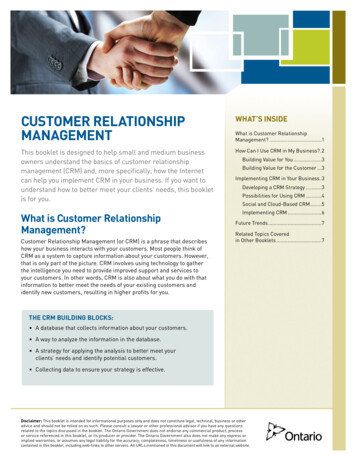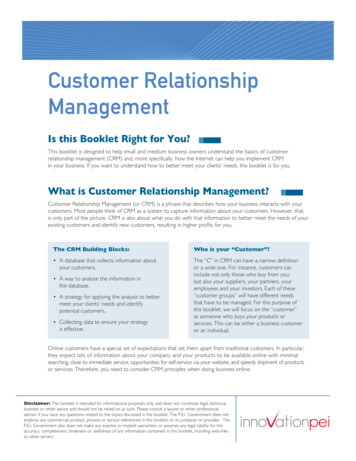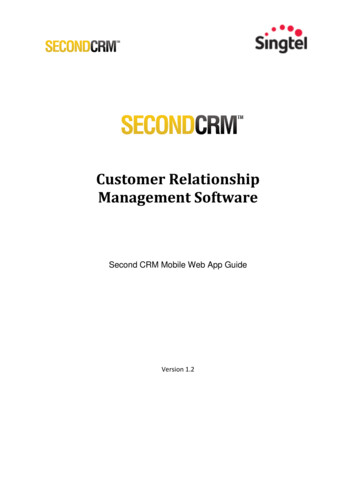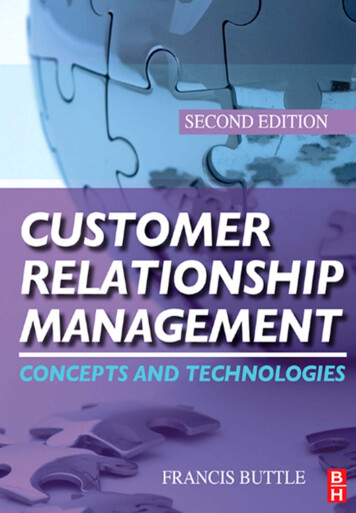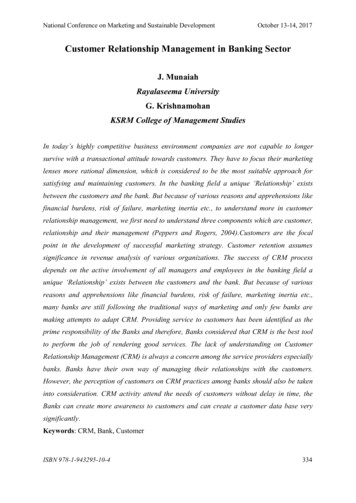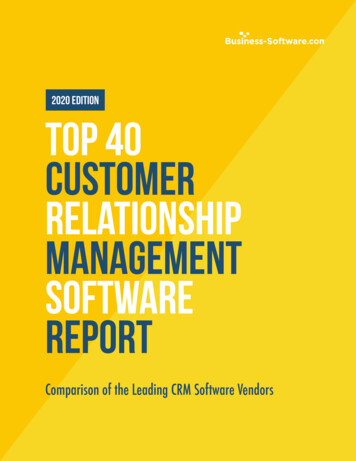
Transcription
Customer Relationship Management (CRM)A multiple case study: analysing the critical factors ofCRM implementationAuthors:Jacqueline Gruber,Tutor: Dan HalvarssonInternational Sales & MarketingExaminer: Dr. Pejvak OghaziMei Hong Svensson,International Sales & MarketingSubject: Relationship ManagementLevel and semester: Bachelor’s Thesis,Spring 20121
“No business can survive without understanding its customers and having apositive relationship with them” (Motiwalla and Tompson, 2009, p. 309)I
AcknowledgementThis thesis is the final part of the Bachelor program in International Sales and Marketing atLinnaeus University, Växjö, Sweden. The graduation work was conducted during the spring term2012.We wish to thank everyone who contributed constructive information to our work. Our gratitudegoes to Electrolux Professional Laundry Systems, Cargotec, Konecranes Lifting Businesses,LasermaxRoll Systems, Strålfors and Svetruck for allowing us to interview their employee’s forour research. Moreover, we would like to thank our interviewees who gave us valuableinformation for this thesis.Additionally, we would like to thank our tutor Dan Halvarsson and our examiner Dr. PejvakOghazi for their guidance and support during our project.Växjö, 23rd May 2012Jacqueline Gruberjacqueline.gruber1@gmail.comMei Hong Svenssonhongwww0365@gmail.comII
AbstractNowadays a company’s focus has shifted from a product-centric view to a more customer-centricview. Customers play a major role for doing business with companies. That leads to the purposeof this research, which is to identify critical factors of CRM implementation and to gain a deeperunderstanding of how companies deal with those critical factors. This was done with the help ofa qualitative method, where six case companies were taken under the research. These six casecompanies are operating in different industries (1) laundry system industry, (2) printing industryand (3) heavy industry. In addition, the aim of this thesis was to find out how CRMimplementation is influenced by critical factors in terms of CRM process and CRM system,interaction of sales force, information / communication flow and organizational structure /culture. The main points which influence the critical factors of CRM implementation were (1)customer-focused, (2) create trust, (3) sharing information and knowledge and (4) decisionmaking. To overcome these points at first companies need to be customer-focused their salesforce need to be able to create trust with customers. Also it is important that companies have awell-implemented information / communication flow to optimise the decision-making process.Within the research more points for how an international organization can manage these criticalfactors are described.The collected data was analysed with the help of the theoretical framework. The conclusion couldbe drawn that, a well implemented CRM would help companies to build a better customerrelationship and to be able to know as much about customers as possible.Key words: CRM, CRM implementation, CRM process and CRM system, interaction ofsales force, information / communication flow, organizational structure / cultureIII
AbbreviationsB2BBusiness to BusinessCRMCustomer Relationship ManagementCSSCustomer Satisfaction SurveyGCRMGlobal Customer RelationshipManagementITInformation TechnologyKPIKey Performance IndicatorROIReturn On InvestmentSAPSystem Application ProgrammingSESwedenIV
Table of Contents1. Introduction . 11.1. Background . 11.2. Problem discussion . 31.3. Purpose . 42. Theoretical framework . 52.1. Customer Relationship Management . 52.2. Critical factors of CRM implementation . 62.2.1. CRM process and CRM system. 62.2.2. Interaction of sales force .132.2.3. Information / communication flow .192.2.4. Organization structure / culture .252.3. Theory framework discussion .282.4. Summary of the theoretical framework .292.5. Research questions.303. Methodology .313.1. Research approach .313.1.1. Inductive vs. deductive research .313.1.2. Qualitative vs. quantitative research .323.2. Research Design .333.3. Data sources .353.4. Research strategy .363.5. Data collection method .393.6. Data collection instrument .423.6.1. Operationalisation and measurement of variables .433.6.2. Interview guide.453.7. Sampling .50V
3.7.1. Sampling frame .503.7.2. Sample selection .543.8. Data analysis method - qualitative approach .563.9. Quality Criteria .583.9.1. Validity and Reliability .583.10. Methodology framework summary .604. Empirical investigation .624.1. Case 1 – Electrolux .624.2. Case 2 – Cargotec .674.3. Case 3 – Konecranes .714.4. Case 4 – LasermaxRoll .764.5. Case 5 – Strålfors .814.6. Case 6 - Svetruck .864.7. Empirical framework summary .895. Analysis .925.1. CRM process and CRM system .925.2. Interaction of sales force .945.3. Information/communication flow .965.4. Organization structure/culture .985.5. Analysis summary . 1016. Conclusion . 1037. Implications . 1047.1. Theoretical implication. 1047.2. Managerial implication . 1058. Limitations and further research . 1068.1. Limitation . 1068.2. Further research . 107VI
List of Reference. 109Table of FiguresFigure 1: Theoretical framework overview . 5Figure 2: CRM core cycle .11Figure 3: The communication cycle.18Figure 4: Theoretical framework summary .30Figure 5: Methodological overview.31Figure 6: Research design .33Figure 7: Guideline for an interview .46Figure 8: Sample frame of six companies .52Figure 9: Two level of sample selection .54Figure 10: Methodology framework summary .61Figure 11: Empirical framework .62Figure 12: Implementation process of Electrolux .64Figure 13: Matrix organization of Electrolux .66Figure 14: Matrix organization of Cargotec .70Figure 15: Benefits of CRM of Konecranes .72Figure 16: Matrix organization of Konecranes .75Figure 17: Business model of LasermaxRoll .77Figure 18: Operational organization of LasermaxRoll .80Figure 19: Why do organizations invest in CRM? .82Figure 20: Collaboration model of Strålfors.84Figure 21: Matrix organization of Strålfors .85Figure 22: Hierarchy organization of Svetruck .89Figure 23: Analysis framework .92Figure 24: CRM process and CRM system .93VII
Figure 25: Interaction of sales force .95Figure 26: Information / communication flow .97Figure 27: Organization structure / culture .99Figure 28: Relationship between critical factors and CRM implementation . 101Table of TablesTable 1: CRM benefit
marketing strategies to deliver profitable, long-term relationships,” (Knox et al., 2003, p. 19). Therefore, to get an expected and positive outcome by implementing CRM approach, there are many challenges and difficulties that companies need to face and overcome, which are discussed in the following chapter.
